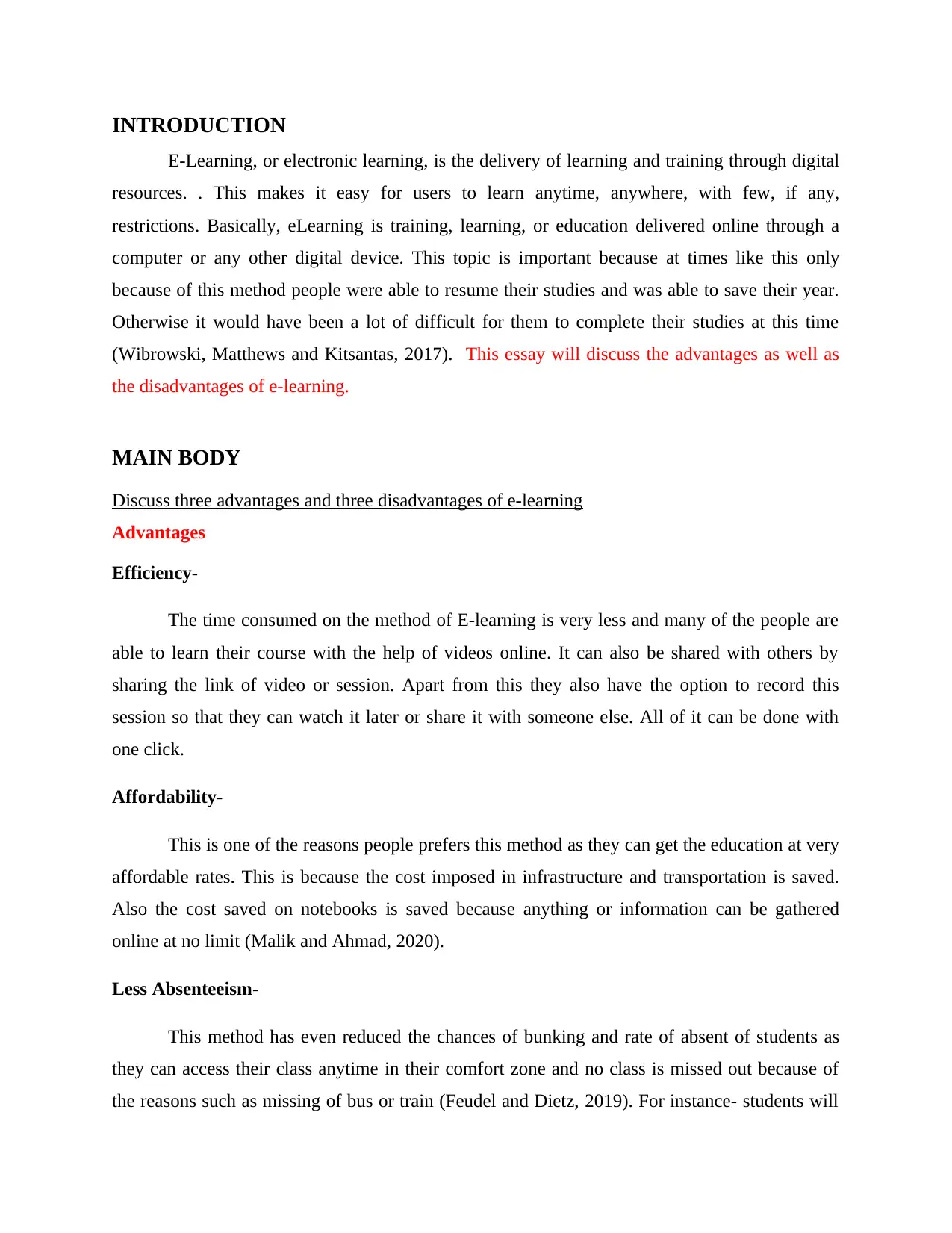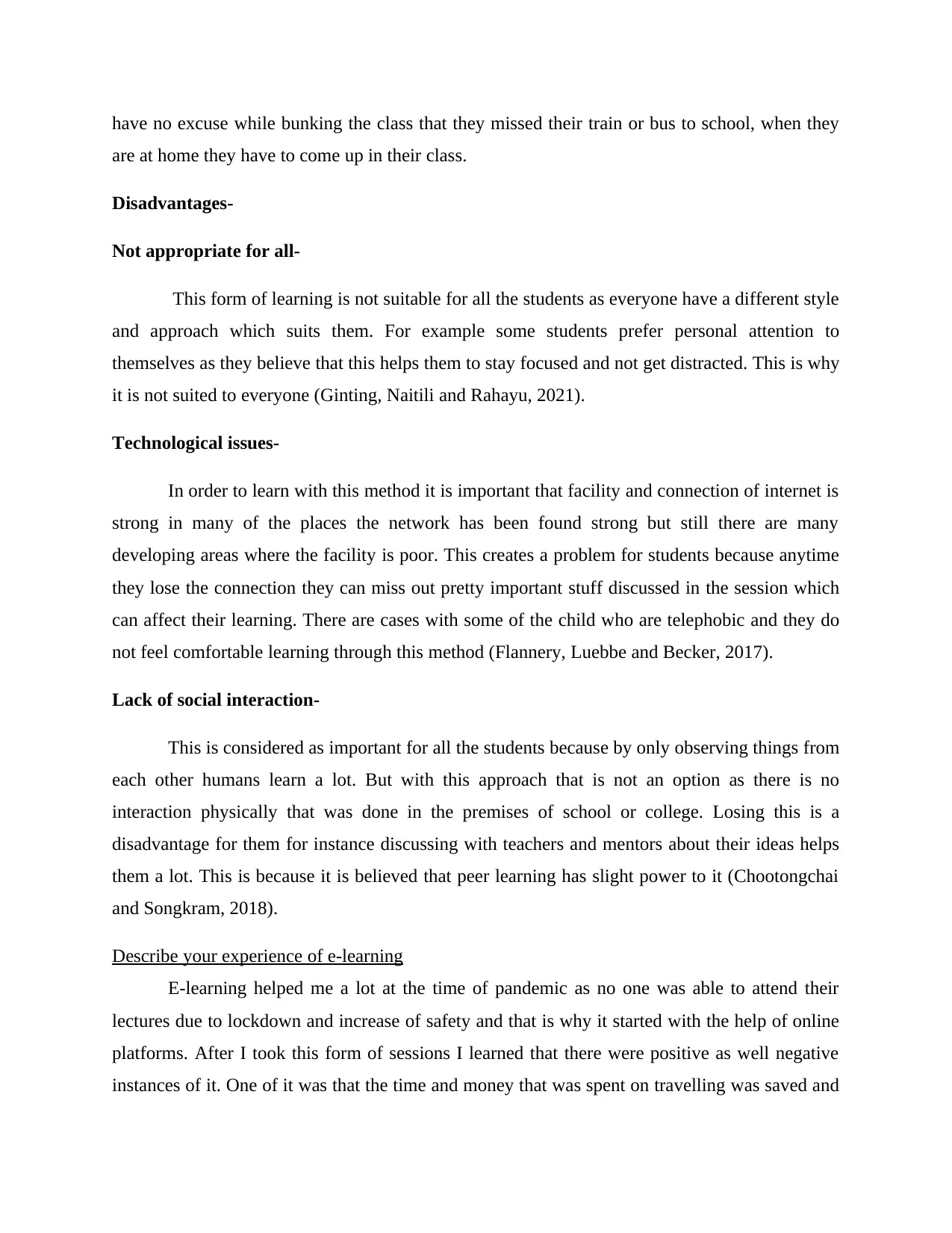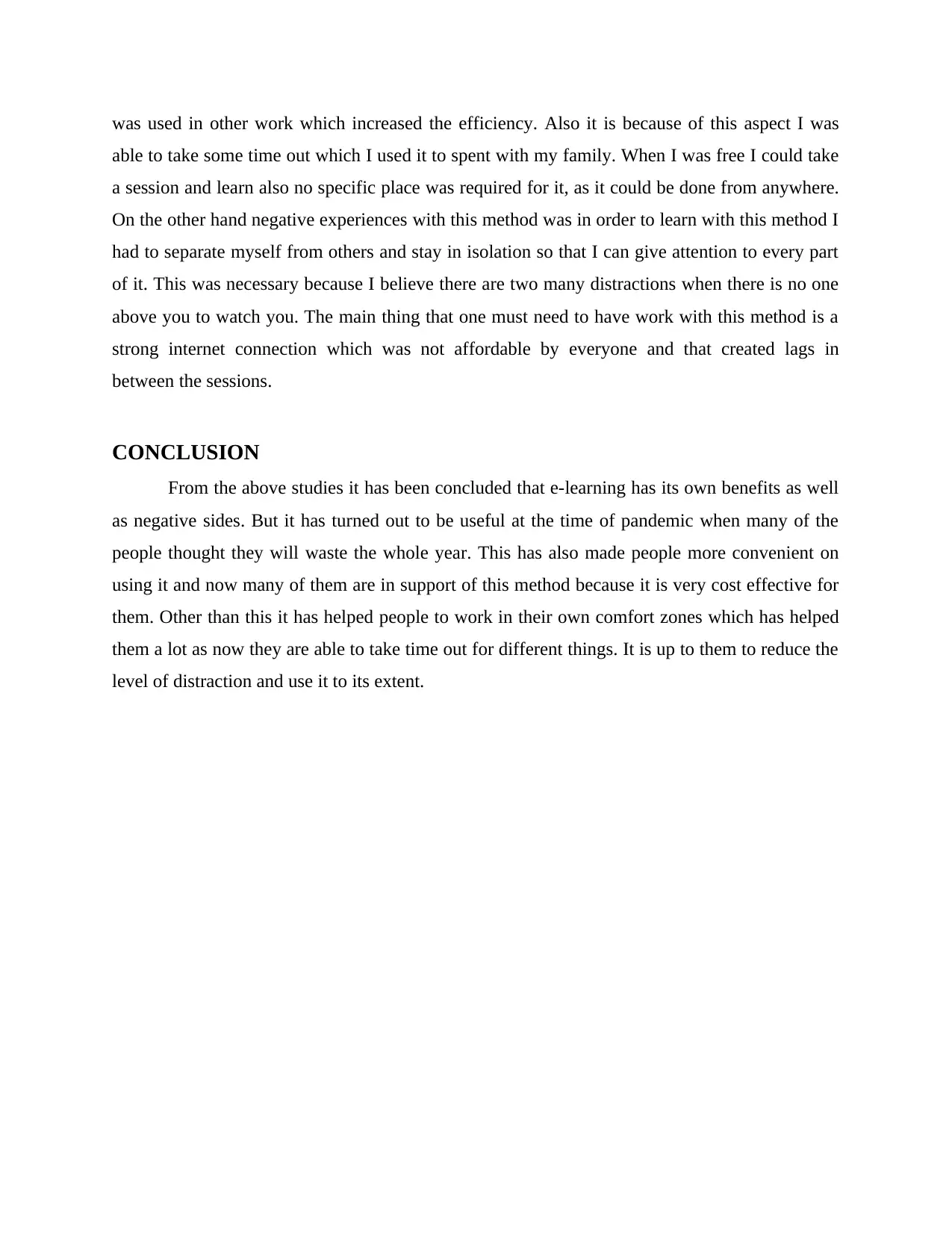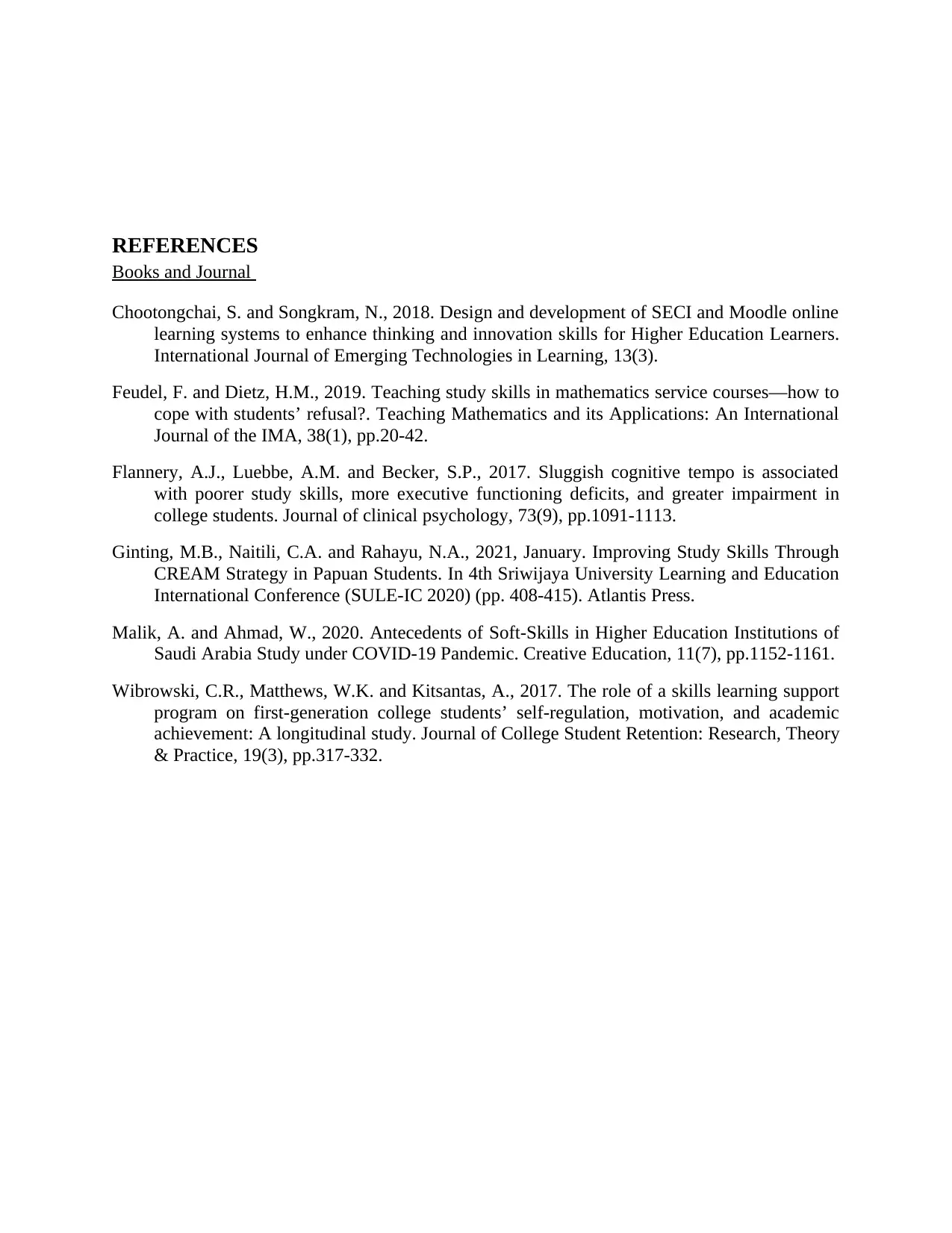The Impact of E-Learning on Higher Education: Pros and Cons
VerifiedAdded on 2022/12/27
|5
|1294
|75
Essay
AI Summary
This essay delves into the realm of e-learning, exploring its multifaceted impact on higher education. It begins by defining e-learning as the delivery of learning through digital resources, highlighting its significance, especially during challenging times like the pandemic. The essay then meticulously outlines three key advantages of e-learning: enhanced efficiency, affordability, and reduced absenteeism. Conversely, it addresses three significant disadvantages, including its unsuitability for all students, potential technological issues, and the limitations in social interaction. The essay further incorporates a personal reflection on the author's e-learning experiences, discussing both the positive aspects, such as time and cost savings, and the negative aspects, such as the need for isolation and the reliance on a strong internet connection. The essay concludes by summarizing the benefits and drawbacks of e-learning, emphasizing its cost-effectiveness and convenience, while also acknowledging the need for students to mitigate distractions and maximize its potential. The essay references several academic sources to support its arguments.

STUDY SKILLS FOR HIGHER
EDUCATION
EDUCATION
Paraphrase This Document
Need a fresh take? Get an instant paraphrase of this document with our AI Paraphraser

INTRODUCTION
E-Learning, or electronic learning, is the delivery of learning and training through digital
resources. . This makes it easy for users to learn anytime, anywhere, with few, if any,
restrictions. Basically, eLearning is training, learning, or education delivered online through a
computer or any other digital device. This topic is important because at times like this only
because of this method people were able to resume their studies and was able to save their year.
Otherwise it would have been a lot of difficult for them to complete their studies at this time
(Wibrowski, Matthews and Kitsantas, 2017). This essay will discuss the advantages as well as
the disadvantages of e-learning.
MAIN BODY
Discuss three advantages and three disadvantages of e-learning
Advantages
Efficiency-
The time consumed on the method of E-learning is very less and many of the people are
able to learn their course with the help of videos online. It can also be shared with others by
sharing the link of video or session. Apart from this they also have the option to record this
session so that they can watch it later or share it with someone else. All of it can be done with
one click.
Affordability-
This is one of the reasons people prefers this method as they can get the education at very
affordable rates. This is because the cost imposed in infrastructure and transportation is saved.
Also the cost saved on notebooks is saved because anything or information can be gathered
online at no limit (Malik and Ahmad, 2020).
Less Absenteeism-
This method has even reduced the chances of bunking and rate of absent of students as
they can access their class anytime in their comfort zone and no class is missed out because of
the reasons such as missing of bus or train (Feudel and Dietz, 2019). For instance- students will
E-Learning, or electronic learning, is the delivery of learning and training through digital
resources. . This makes it easy for users to learn anytime, anywhere, with few, if any,
restrictions. Basically, eLearning is training, learning, or education delivered online through a
computer or any other digital device. This topic is important because at times like this only
because of this method people were able to resume their studies and was able to save their year.
Otherwise it would have been a lot of difficult for them to complete their studies at this time
(Wibrowski, Matthews and Kitsantas, 2017). This essay will discuss the advantages as well as
the disadvantages of e-learning.
MAIN BODY
Discuss three advantages and three disadvantages of e-learning
Advantages
Efficiency-
The time consumed on the method of E-learning is very less and many of the people are
able to learn their course with the help of videos online. It can also be shared with others by
sharing the link of video or session. Apart from this they also have the option to record this
session so that they can watch it later or share it with someone else. All of it can be done with
one click.
Affordability-
This is one of the reasons people prefers this method as they can get the education at very
affordable rates. This is because the cost imposed in infrastructure and transportation is saved.
Also the cost saved on notebooks is saved because anything or information can be gathered
online at no limit (Malik and Ahmad, 2020).
Less Absenteeism-
This method has even reduced the chances of bunking and rate of absent of students as
they can access their class anytime in their comfort zone and no class is missed out because of
the reasons such as missing of bus or train (Feudel and Dietz, 2019). For instance- students will

have no excuse while bunking the class that they missed their train or bus to school, when they
are at home they have to come up in their class.
Disadvantages-
Not appropriate for all-
This form of learning is not suitable for all the students as everyone have a different style
and approach which suits them. For example some students prefer personal attention to
themselves as they believe that this helps them to stay focused and not get distracted. This is why
it is not suited to everyone (Ginting, Naitili and Rahayu, 2021).
Technological issues-
In order to learn with this method it is important that facility and connection of internet is
strong in many of the places the network has been found strong but still there are many
developing areas where the facility is poor. This creates a problem for students because anytime
they lose the connection they can miss out pretty important stuff discussed in the session which
can affect their learning. There are cases with some of the child who are telephobic and they do
not feel comfortable learning through this method (Flannery, Luebbe and Becker, 2017).
Lack of social interaction-
This is considered as important for all the students because by only observing things from
each other humans learn a lot. But with this approach that is not an option as there is no
interaction physically that was done in the premises of school or college. Losing this is a
disadvantage for them for instance discussing with teachers and mentors about their ideas helps
them a lot. This is because it is believed that peer learning has slight power to it (Chootongchai
and Songkram, 2018).
Describe your experience of e-learning
E-learning helped me a lot at the time of pandemic as no one was able to attend their
lectures due to lockdown and increase of safety and that is why it started with the help of online
platforms. After I took this form of sessions I learned that there were positive as well negative
instances of it. One of it was that the time and money that was spent on travelling was saved and
are at home they have to come up in their class.
Disadvantages-
Not appropriate for all-
This form of learning is not suitable for all the students as everyone have a different style
and approach which suits them. For example some students prefer personal attention to
themselves as they believe that this helps them to stay focused and not get distracted. This is why
it is not suited to everyone (Ginting, Naitili and Rahayu, 2021).
Technological issues-
In order to learn with this method it is important that facility and connection of internet is
strong in many of the places the network has been found strong but still there are many
developing areas where the facility is poor. This creates a problem for students because anytime
they lose the connection they can miss out pretty important stuff discussed in the session which
can affect their learning. There are cases with some of the child who are telephobic and they do
not feel comfortable learning through this method (Flannery, Luebbe and Becker, 2017).
Lack of social interaction-
This is considered as important for all the students because by only observing things from
each other humans learn a lot. But with this approach that is not an option as there is no
interaction physically that was done in the premises of school or college. Losing this is a
disadvantage for them for instance discussing with teachers and mentors about their ideas helps
them a lot. This is because it is believed that peer learning has slight power to it (Chootongchai
and Songkram, 2018).
Describe your experience of e-learning
E-learning helped me a lot at the time of pandemic as no one was able to attend their
lectures due to lockdown and increase of safety and that is why it started with the help of online
platforms. After I took this form of sessions I learned that there were positive as well negative
instances of it. One of it was that the time and money that was spent on travelling was saved and
⊘ This is a preview!⊘
Do you want full access?
Subscribe today to unlock all pages.

Trusted by 1+ million students worldwide

was used in other work which increased the efficiency. Also it is because of this aspect I was
able to take some time out which I used it to spent with my family. When I was free I could take
a session and learn also no specific place was required for it, as it could be done from anywhere.
On the other hand negative experiences with this method was in order to learn with this method I
had to separate myself from others and stay in isolation so that I can give attention to every part
of it. This was necessary because I believe there are two many distractions when there is no one
above you to watch you. The main thing that one must need to have work with this method is a
strong internet connection which was not affordable by everyone and that created lags in
between the sessions.
CONCLUSION
From the above studies it has been concluded that e-learning has its own benefits as well
as negative sides. But it has turned out to be useful at the time of pandemic when many of the
people thought they will waste the whole year. This has also made people more convenient on
using it and now many of them are in support of this method because it is very cost effective for
them. Other than this it has helped people to work in their own comfort zones which has helped
them a lot as now they are able to take time out for different things. It is up to them to reduce the
level of distraction and use it to its extent.
able to take some time out which I used it to spent with my family. When I was free I could take
a session and learn also no specific place was required for it, as it could be done from anywhere.
On the other hand negative experiences with this method was in order to learn with this method I
had to separate myself from others and stay in isolation so that I can give attention to every part
of it. This was necessary because I believe there are two many distractions when there is no one
above you to watch you. The main thing that one must need to have work with this method is a
strong internet connection which was not affordable by everyone and that created lags in
between the sessions.
CONCLUSION
From the above studies it has been concluded that e-learning has its own benefits as well
as negative sides. But it has turned out to be useful at the time of pandemic when many of the
people thought they will waste the whole year. This has also made people more convenient on
using it and now many of them are in support of this method because it is very cost effective for
them. Other than this it has helped people to work in their own comfort zones which has helped
them a lot as now they are able to take time out for different things. It is up to them to reduce the
level of distraction and use it to its extent.
Paraphrase This Document
Need a fresh take? Get an instant paraphrase of this document with our AI Paraphraser

REFERENCES
Books and Journal
Chootongchai, S. and Songkram, N., 2018. Design and development of SECI and Moodle online
learning systems to enhance thinking and innovation skills for Higher Education Learners.
International Journal of Emerging Technologies in Learning, 13(3).
Feudel, F. and Dietz, H.M., 2019. Teaching study skills in mathematics service courses—how to
cope with students’ refusal?. Teaching Mathematics and its Applications: An International
Journal of the IMA, 38(1), pp.20-42.
Flannery, A.J., Luebbe, A.M. and Becker, S.P., 2017. Sluggish cognitive tempo is associated
with poorer study skills, more executive functioning deficits, and greater impairment in
college students. Journal of clinical psychology, 73(9), pp.1091-1113.
Ginting, M.B., Naitili, C.A. and Rahayu, N.A., 2021, January. Improving Study Skills Through
CREAM Strategy in Papuan Students. In 4th Sriwijaya University Learning and Education
International Conference (SULE-IC 2020) (pp. 408-415). Atlantis Press.
Malik, A. and Ahmad, W., 2020. Antecedents of Soft-Skills in Higher Education Institutions of
Saudi Arabia Study under COVID-19 Pandemic. Creative Education, 11(7), pp.1152-1161.
Wibrowski, C.R., Matthews, W.K. and Kitsantas, A., 2017. The role of a skills learning support
program on first-generation college students’ self-regulation, motivation, and academic
achievement: A longitudinal study. Journal of College Student Retention: Research, Theory
& Practice, 19(3), pp.317-332.
Books and Journal
Chootongchai, S. and Songkram, N., 2018. Design and development of SECI and Moodle online
learning systems to enhance thinking and innovation skills for Higher Education Learners.
International Journal of Emerging Technologies in Learning, 13(3).
Feudel, F. and Dietz, H.M., 2019. Teaching study skills in mathematics service courses—how to
cope with students’ refusal?. Teaching Mathematics and its Applications: An International
Journal of the IMA, 38(1), pp.20-42.
Flannery, A.J., Luebbe, A.M. and Becker, S.P., 2017. Sluggish cognitive tempo is associated
with poorer study skills, more executive functioning deficits, and greater impairment in
college students. Journal of clinical psychology, 73(9), pp.1091-1113.
Ginting, M.B., Naitili, C.A. and Rahayu, N.A., 2021, January. Improving Study Skills Through
CREAM Strategy in Papuan Students. In 4th Sriwijaya University Learning and Education
International Conference (SULE-IC 2020) (pp. 408-415). Atlantis Press.
Malik, A. and Ahmad, W., 2020. Antecedents of Soft-Skills in Higher Education Institutions of
Saudi Arabia Study under COVID-19 Pandemic. Creative Education, 11(7), pp.1152-1161.
Wibrowski, C.R., Matthews, W.K. and Kitsantas, A., 2017. The role of a skills learning support
program on first-generation college students’ self-regulation, motivation, and academic
achievement: A longitudinal study. Journal of College Student Retention: Research, Theory
& Practice, 19(3), pp.317-332.
1 out of 5
Related Documents
Your All-in-One AI-Powered Toolkit for Academic Success.
+13062052269
info@desklib.com
Available 24*7 on WhatsApp / Email
![[object Object]](/_next/static/media/star-bottom.7253800d.svg)
Unlock your academic potential
Copyright © 2020–2025 A2Z Services. All Rights Reserved. Developed and managed by ZUCOL.




